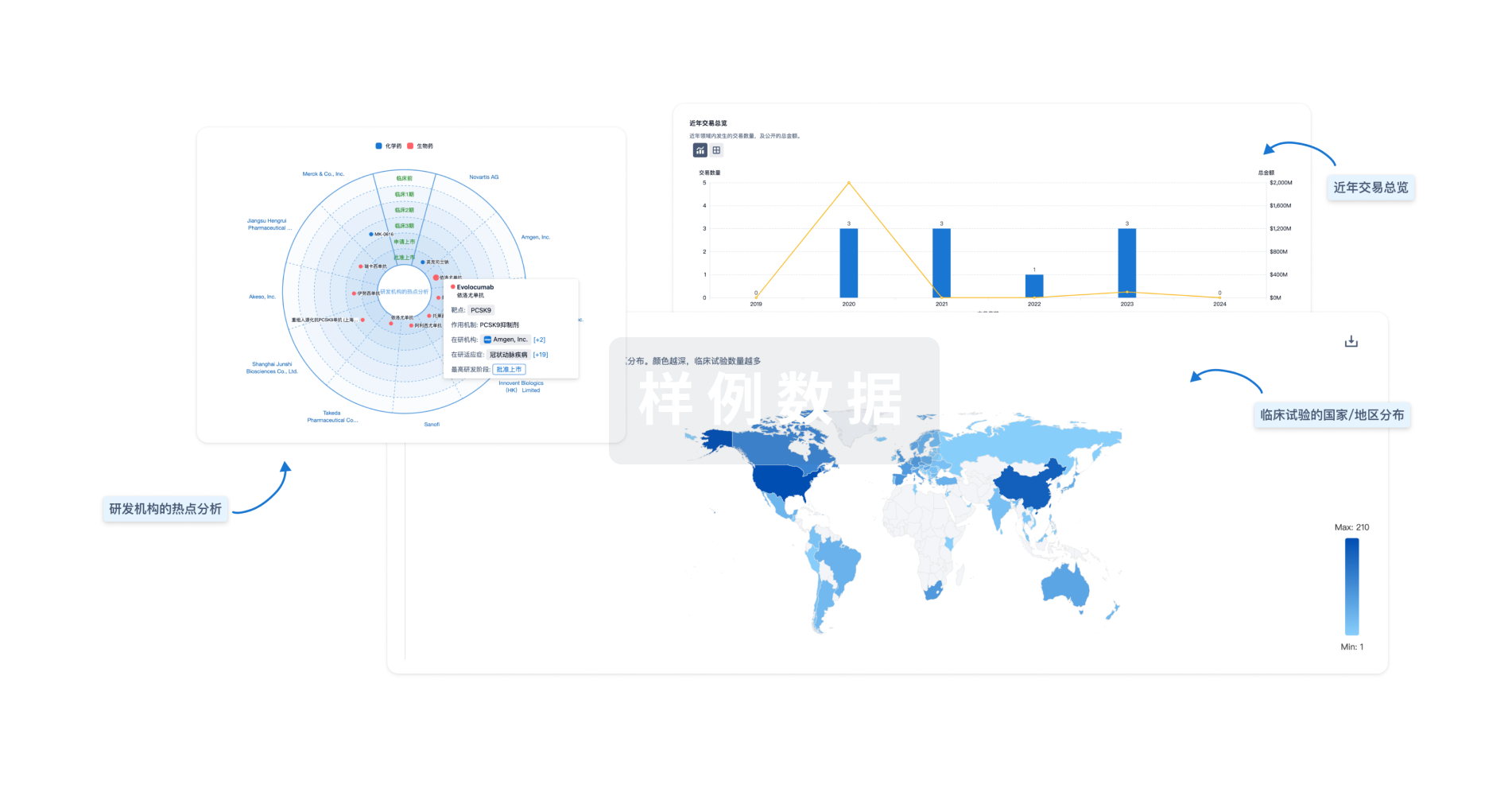预约演示
更新于:2025-05-07
CSAD
更新于:2025-05-07
基本信息
别名 Aspartate 1-decarboxylase、CSAD、CSD + [4] |
简介 Catalyzes the decarboxylation of L-aspartate, 3-sulfino-L-alanine (cysteine sulfinic acid), and L-cysteate to beta-alanine, hypotaurine and taurine, respectively. The preferred substrate is 3-sulfino-L-alanine. Does not exhibit any decarboxylation activity toward glutamate. |
关联
100 项与 CSAD 相关的临床结果
登录后查看更多信息
100 项与 CSAD 相关的转化医学
登录后查看更多信息
0 项与 CSAD 相关的专利(医药)
登录后查看更多信息
643
项与 CSAD 相关的文献(医药)2025-04-02·The Plant Cell
The circular RNA circANK suppresses rice resistance to bacterial blight by inhibiting microRNA398b-mediated defense
Article
作者: Ouyang, Mingyan ; Lin, Rongpeng ; Liao, Weixue ; Wang, Peihong ; Zhu, Bo ; Feng, Xurui ; Michalopoulou, Vasiliki ; Zhang, Zinan ; Xu, Zhengyin ; Liu, Xiaohui ; Lin, Sisi ; Chen, Gongyou ; Wang, Sai ; Sarris, Panagiotis F
2025-04-01·Plant Molecular Biology
Tomato miR398 knockout disrupts ROS dynamics during stress conferring heat tolerance but hypersusceptibility to necrotroph infection
Article
作者: Kundu, Pallob ; Das, Rohit ; Mukherjee, Ananya ; Talukdar, Sushmita ; Chowdhury, Shreya ; Mal, Sayan ; Basak, Shrabani ; Singh, Raghuvir
2025-03-20·Nucleic Acids Research
A dynamic structural unit of phase-separated heterochromatin protein 1α as revealed by integrative structural analyses
Article
作者: Shimizu, Kentaro ; Shimizu, Nobutaka ; Yonezawa, Kento ; Hayashi, Aki ; Nakayama, Jun-ichi ; Negami, Tatsuki ; Senda, Toshiya ; Adachi, Naruhiko ; Terada, Tohru ; Nishimura, Yoshifumi ; Furukawa, Ayako ; Yoshimura, Yuriko
2
项与 CSAD 相关的新闻(医药)2023-10-04
To date it has been unclear exactly how the sex of a bee is determined. A research team comprising biologists and chemists has now identified a key gene and the molecular mechanism linked with it. They describe how this process is similar to a game involving two dice.
To date it has been unclear exactly how the sex of a bee is determined. A research team from Heinrich Heine University Düsseldorf (HHU) comprising biologists and chemists has now identified a key gene and the molecular mechanism linked with it. In the current issue of the scientific journal Science Advances, they describe how this process is similar to a game involving two dice.
The sex of a living creature has significant consequences for its form, function and behaviour. The biological sex of an organism is usually determined at the start of its life. In humans, for example, the presence of the sex-determining "Y chromosome" decides whether a man will be born.
The Silesian priest Johann Dzierzon already examined the sex-determining mechanisms of honeybees (Apis mellifera) back in 1845. Among other things, he discovered the asexual reproduction of male bees -- the "drones."
Bees -- unlike humans -- do not have just one sex-determining chromosome. A research team headed by Professor Dr Martin Beye from the Institute of Evolutionary Genetics at HHU has now established that the sex is determined by a single gene, referred to as "Csd" (Complementary sex determiner) via a special mechanism.
This gene can have more than 100 variations, so-called alleles. In other cases, e.g. in flowers, the various alleles of a gene can determine petal colour.
In the case of sexual fertilisation, the simple chromosome sets from the egg and sperm cells come together to create a double -- diploid -- chromosome set. Accordingly, two Csd gene variants are now present in each sexually fertilized bee.
The next finding of the bee researchers in Düsseldorf: Where the two alleles of the Csd gene are different, a female bee develops. By contrast, if the alleles of the gene are the same on both chromosomes, a male bee develops. However, as the bees want to prevent this to avoid inbreeding, the worker bees do not raise these eggs.
The question remained as to how this sex determination occurs at molecular level. Lead author Dr Marianne Otte: "It is necessary to know here that each different allele of the Csd gene produces a different variant of the associated Csd protein, all of which differ slightly. We were able to demonstrate that only different Csd proteins can bind with each other and thus activate a molecular switch that determines 'female bee'. By contrast, if the proteins are the same, they bind differently and the switch is not activated. In this case, a male bee would develop, but it is not raised."
Professor Beye, last author of the study in Science Advances: "It is similar to a molecular game involving two dice: However, in this case, the throw that produces a double is not the winner. Instead, the throw must produce two different numbers to enable a new bee -- a female -- to be raised."
By contrast, the drones develop from unfertilised eggs. Accordingly, these male bees only have a simple chromosome set with identical Csd proteins. The queen bee decides not to add sperm to the egg during the laying process.
Dr Otte: "We have been able to solve a genetic mystery that has existed for more than 100 years by tracing it back to the switch function of the Csd protein." Professor Beye comments on further research questions: "The mechanism the worker bees use to identify whether the fertilised egg contains two different Csd proteins and is thus switched to 'female' is still unknown. As it is dark inside the hive, there must be an olfactory clue."
The results will be used to advance bee breeding measures.
2022-07-26
摘要:通过使用杆状病毒表达载体系统 (BEVS),在昆虫细胞中生产重组蛋白成为趋势。尽管许多蛋白质通过该平台成功表达,但由于细胞病变效应、共感染和共表达的不可预测性以及杆状病毒基因组不稳定性等问题,一些蛋白仍然无法成功表达。为了在昆虫细胞中表达不同的蛋白质,已经对许多启动子进行了研究,但在调查市售杆状病毒载体时,发现新启动子的使用仍然匮乏。在推进该平台生产更多种类的蛋白质和复合物的过程中,此类新载体的开发是不可避免的。深刻地认识病毒基因表达调控和启动子(如病毒本身的、合成的和昆虫来源的启动子)的选择原理,将有利于研究人员合理协调并利用这些复杂的基因调控机制来增加BEVS异源基因表达的成功率。在这里,我们总结了一些可用于改善昆虫细胞中重组蛋白和多蛋白复合物表达的研究进展。1 前言杆状病毒表达载体系统(BEVS)被用作生产重组蛋白的工具已经有40多年的历史了。最早由德克萨斯大学的一个小组证明了它的用途,它被用于产生人β干扰素。这项工作是最早的相关研究论文,他们展示了该系统在生产具有生物活性重组蛋白方面的巨大潜力。从那时起,众多研究人员对该系统进行了重大改进,现在已被用作一个通用的蛋白表达平台。来自BEVS的蛋白质已用于生化、生物物理和结构生物学研究,并继续用于药物开发和癌症研究。由于其高度特异性的宿主范围,重组杆状病毒也被用作杀虫剂的安全绿色的替代品,并且最近已成为人类疫苗生产的重要工具。即使多年来该系统的多样性得以发展,但基本设计仍然保持不变。产生重组杆状病毒,选择的外源基因置于天然启动子的控制下,然后在感染周期中表达,在细胞裂解过程中释放蛋白质。为了达到最大表达水平,大多数利用极晚的启动子来驱动外源基因的表达。虽然当需要大量重组蛋白时,这种方法通常是成功的,但在某些情况下,使用表达较早或较弱的替代启动子可能有利于最终蛋白质的质量和产量。在快速表达过程中发生聚集的蛋白质和需要高级翻译后修饰的蛋白质也被证明可以使用早期启动子的持续稳定表达中获得理想的产物。此外,当共表达蛋白质时,使用多个强的极晚期启动子会给细胞带来负担,并导致蛋白质产量不佳。由于这些原因,使用替代启动子可能有利于外源基因表达产物的精细调控和最优表达。杆状病毒基因的表达调控主要是通过使用各种启动子、基序、转录因子和一种新型病毒编码的RNA聚合酶在转录水平上调节。根据生产过程特性的需求对载体进行更大程度的定制化将有助于研究人员充分利用BEVS的潜力。在这篇综述中,我们将讨论商业化的强启动子和晚期表达启动子之外的选择,这些选择可以利用整个杆状病毒感染周期来优化蛋白质生产(见图1)。2 草地贪夜蛾多核多角体病毒(AcMNPV)AcMNPV是一种感染鳞翅目昆虫的高致病性杆状病毒,是昆虫细胞中重组蛋白生产最常用的杆状病毒。它的基因组由编码超过150个基因的双链DNA组成。杆状病毒的感染过程具有时序性,可分为立即早期、早期、晚期和极晚期。这些节点是由被转录的基因和感染后它们被表达的小时数来定义的。立即早期基因是第一个被表达的病毒基因。研究发现mRNA转录产物最早在感染后30分钟就可以检测到了,并持续长达6小时,尽管有一些必需基因的启动子在感染周期的后期仍然活跃。立即早期基因产物主要是早期基因转录所必需的转录激活剂。立即早期和早期基因都在病毒DNA复制之前开始转录,并利用宿主RNA聚合酶II。病毒DNA复制的开始表示向晚期基因表达的转变。这种转变通常发生在感染后6小时,随后产生出芽的病毒粒子。时程转录研究表明,随着DNA复制,晚期mRNA转录物在细胞内迅速增加,而宿主mRNA则稳定下降。晚期基因由新型杆状病毒RNA聚合酶转录,其表达依赖于病毒DNA复制。许多晚期基因是结构基因,时感染后12-18小时产生的芽生型病毒粒子 (budded viruses, BV) 和包埋型病毒粒子 (Occlusion derived virus, ODV) 所必需的基因。从大约感染后18小时开始并持续到细胞裂解是极晚期的阶段。这是感染的最后阶段,与包埋型病毒粒子的形成和包括多角体蛋白在内的几个基因的过度表达有关。极晚期的基因经历了快速的转录爆发,导致它们的基因产物在细胞中大量积累,而此时几乎所有宿主基因的表达都减少了,从而可以将细胞资源用于快速产生病毒后代。由于这种高活性,多角体启动子被认为是杆状病毒表达系统的标准启动子。3. 立即早期和早期启动子立即早期和早期启动子在病毒DNA复制之前被激活。立即早期启动子由宿主细胞RNA聚合酶II转录,也利用宿主的转录因子。立即早期和早期启动子的结构组织与晚期和极晚期杆状病毒启动子有很大不同,而是更类似于其他真核启动子的结构。杆状病毒立即早期启动子最显着的特征是保守的CAGT基序,其作为转录起始位点并在调节下游基因表达中起重要作用。在某些情况下,立即早期启动子包含一个TATA样基序和/或一个起始序列。该区域被宿主RNA聚合酶II识别,并允许在感染后马上转录立即早期病毒基因。为了确定CAGT基序的功能,Pullen等人,在杆状病毒IE-1启动子的这个序列中引入了该位点的特异性突变。结果发现,CAGT基序序列的改变降低了mRNA的水平并降低了整体启动子的表达效率。虽然一些早期启动子包含CAGT基序,但许多不包含,但它们通常需要立即早期基因进行反式激活。IE1启动子是一种立即早期启动子,是最常用于杆状病毒表达的组成型启动子,因为它在所有时间阶段以及未感染的昆虫细胞中都具有活性。 因此,它经常用于瞬时表达质粒;IE0/IEI和IE2的启动子也以这种方式使用。39k启动子是一种早期启动子,它被IE1蛋白反式激活。当与IE1 蛋白共表达时,39k启动子也可以暂时使用。已证明IE1和39k启动子对分泌蛋白的生产特别有用。4.晚期启动子晚期启动子由识别保守的(A/G/T)TAAG晚期/极晚期启动子基序的病毒RNA 聚合酶转录。转录起始于该基序内的第二个核苷酸,并且它的存在是启动子活性必需的。调查晚期启动子中TAAG基序功能的研究表明,该序列中的突变破坏了转录。热力学稳定性,而不是其周围核苷酸的序列特异性,决定了它作为晚期启动子的功能,这表明链分离的容易性和病毒聚合酶的进入有助于转录调节。杆状病毒利用由四个亚基(LEF-8、LEF-4、LEF-9 和 p47)组成的新型α鹅膏菌素抗性RNA聚合酶,它在引导细胞资源用于子代病毒生产方面发挥重要作用。编码聚合酶亚基的基因在感染过程的早期利用宿主机器进行转录。当杆状病毒聚合酶组装并且DNA复制接近完成时,晚期和极晚期病毒基因的转录便可以开始。这是通过病毒RNA聚合酶识别TAAG基序来实现的,这可以使病毒基因能够独立于宿主转录机制进行表达,从而防止与宿主基因的竞争。在对一些晚期表达因子进行更深入的研究后发现,有几个因子对于质粒复制或刺激质粒复制是必不可少的,这表明杆状病毒晚期基因转录可能与宿主DNA复制同时发生的,而不是在复制完成之后。由于CAGT和TAAG元件的存在,不论是在早期还是晚期阶段,gp64启动子均可以被IE1反式激活,表现出活性。在BEVS中,gp64启动子经常与gp64融合的异源蛋白连接用于病毒蛋白的展示。更常用的是晚期启动子,包括p6.9和pCap。核衣壳中与病毒DNAs相关的富含精氨酸的6.9kDa基础蛋白vp39是由pCap启动子驱动表达。通常这些非常晚期的启动子表达的蛋白均表现出功能失调或者聚集。早期的启动子表达的重组蛋白通常表现出更好的质量,启动子pCap在hr3增强子存在时,由于hr3增强子长时间调节表达蛋白收获量与晚期启动子表达量相似。据推测,可能杆状病毒感染期间宿主细胞健康状况的下降从而导致蛋白质量控制不佳和蛋白质聚集;尚不清楚为什么某些重组蛋白会出现这种情况,而并非所有蛋白都是如此。5 非常晚期启动子非常晚期的启动子活性在感染后18-24 小时达到峰值,并超过晚期启动子活性。在感染后24h时,非常晚期启动子在细胞中的转录水平超过其他所有的启动子。由于非常晚期启动子含有TAAG元件和转录起始位点,所以非常晚期启动子也可以被杆状病毒RNA聚合酶所识别。多面体蛋白和p10基因的TAAG转录起始位点和ATG启动子之间的富含的AT区域被认为是突发序列,进一步区分了这些非常晚期基因启动子区域。尽管这2个启动子序列有差异,但是他们的存在对于晚期基因的爆发表达是非常重要的。突发序列的突变将导致基因表达量降低10-20倍。非常晚期转录调节因子Vlf-1就是结合在突发序列上促进下游基因的过表达。在天然病毒感染的细胞中,多角体蛋白在ODVs周围形成结晶体基质保护蛋白免受细胞环境失活的影响,使ODVs在病毒感染结束时积累高达50%细胞蛋白总量。然而在实验室培养的昆虫细胞研究人员首选使用BEVS来进行外源基因的替换,而不是必须使用病毒感染。在感染周期中多角体蛋白启动子在非常晚期时很活跃,而且在大约感染后18小时时会有一个爆发性的转录活性。Possee和Howard首次界定多角体蛋白基因ATG上游的69bp为多角体蛋白启动子,后来Rankin也鉴定出这个区域是多角体蛋白基因表达所必须的。Morris和Miller证实了经过多角体蛋白启动子表达的报告基因分别比晚期启动子高2-3倍和比早期启动子高10-20倍。多角体蛋白启动子介导的外源基因蛋白表达常常会有显著的蛋白产物累积,由于多角体蛋白启动子非常晚期的表达活性,释放的病毒蛋白酶使宿主细胞产生显著的细胞病理学特征,会导致其使用受到限制,这些以及其他许多推测的不确定因素产生的效应可能使得产生蛋白包涵体,蛋白错误折叠或者分泌效率低下,从而使蛋白质量较差。P10蛋白在感染周期的非常晚期高水平表达,被认为在病毒释放所需的包涵体成熟和细胞裂解中发挥作用。Weyer和Possee首次将p10基因ATG上游101个核苷酸定义为p10启动子序列,并建议将其用于外源蛋白的表达。从那时起,p10启动子被广泛应用于BEVS中生产蛋白质,比如花椰菜花叶病毒基因1和人白介素2的生产。P10也可以用来连接其他启动子用于共表达,比如Furuta用来生产6D9抗体的Fab片段,Song用来生产抗结直肠癌单克隆抗体CO17-1A。与多角蛋白启动子相比,p10启动子激活要早几个小时,转录水平要稍微低于多角蛋白启动子。6 非常晚期启动子杂合体杂合启动子构建涉及全启动子区域的配对来增加表达的持续时间。P10启动子和各种启动子可以成功配对,当与IE1共表达时,p10-p6.9(TB3)的杂合启动子表达的GFP水平最高,比多角体蛋白启动子表达的GFP高4.5倍。当Vp39启动子pCap和多角体蛋白启动子配对时在晚期阶段可获得更高水平的蛋白表达,而多角体蛋白启动子在感染后6小时时就可以检测出转录产物,直到非常晚期才开始过表达。当CMVmin启动子和多角蛋白pu区域(ORF4、ORF5和lef2)基因上游序列再加上一个hr时,不需要Tet反式激活元件的刺激就有活性。pu区域中的这3个基因任何一个基因的突变或者删除,CMVmin启动子都会丧失类似的高表达能力。ORF4和ORF5的特性还不确定,但是lef2在转录和质粒复制中发挥作用。通过在多角蛋白启动子尾部增加一定数量的(1-16)突发序列加上ie-2启动子vlf-1过表达区域合成出一些新的多角蛋白启动子。在High Five细胞中,增加2-5个突发序列靶蛋白有更高的表达量,其中增加2个突发序列的启动子与多角蛋白原始启动子相比具有最高的表达性能。其他杆状病毒或者生物启动子也被用来增加AcMNPV的非常晚期的表达。经过转录组分析,Spodoptera exigua杆状病毒orf46启动子SeMNPV具有高转录活性。orf46启动子在AcMNPV中表现出高水平的晚期表达,但当置于多角体启动子下游时,eGFP的表达增加了2倍。将龙虾原肌球蛋白cDNA的前导序列L21置于多角体蛋白启动子的下游,荧光素酶的表达比单独的多角体蛋白启动子高了7倍。7 增强子增强子是富含AT重复或者回文结构的同源区域,此区域经常会出现EcoRI酶切位点[55]。为杆状病毒启动子添加增强子可以大大提高蛋白产量。AcMNPV基因组包含9个增强子同源区域(hr1,hr1a,hr2,hr2a,hr3,hr4a,hr4b,hr4c和hr5)序列。hrs除了作为增强子还具有复制起始的功能。当放置在果蝇hsp70启动子下游时,hr1作为38kDa的hr1-BP蛋白结合位点来增加异源基因的表达。当增强子置于荧光素酶报告基因下游时,多角体蛋白启动子表达也提高了11倍。在Sf9细胞中Hr2增强子与rAAV启动子RBE联用来提高基因表达。在家蚕幼虫中IE1启动子和BmNPV hr3增强子联用可以获得高蛋白产量,当hr3和晚期启动子vp39联用时除了获得更高的蛋白产量还降低了蛋白聚集。当39K启动子添加了hr5增强子,IE1基因表达量增加了10倍。IE1启动子上游增加了hr5启动子CAT表达增加了5倍。除了hr增强子p143[62]基因的部分区域在昆虫和哺乳动物细胞同样具有增强子的作用。8 下调元件据报道,启动子区域中ATG密码子和小顺反子的上游区在杆状病毒基因表达中发挥调节作用。由于所处位置和环境,这些区域可以影响启动子的强度而且有下调基因表达的潜能。当对杆状病毒gp64晚期启动子内的天然小顺反子进行点突变,由于点突变干扰了小顺反子的功能导致gp64晚期启动子下游的报告基因表达水平提高。当对所有ATG密码子上游区域包括小顺反子区域进行突变,报告基因表达水平达到最大,表明小顺反子在杆状病毒基因表达中起负调控作用。类似的,Luckow通过改变多角蛋白启动子前导序列,构建了多个杆状病毒重组蛋白表达载体,来更好的理解翻译信号对蛋白高表达的重要作用。当多角蛋白部分编码序列与下游基因融合时,观察到更高水平的外源蛋白表达,同时连接多角蛋白部分序列的mRNA水平也更高。由于重组蛋白N端引入了额外的氨基酸序列,可能导致一些额外的不良影响,研究小组后来着手确认最优的高水平的非融合外源蛋白的表达方案。保持多角蛋白前导序列完整的同时将ATG突变为ATT,随后直接插入外源基因,外源基因的表达水平与野生多角蛋白表达水平相当。当多角蛋白启动子被突变为ATT,阅读框中含有含启动子的外源基因,此融合基因可以正常表达,但是表达水平要低于ATG未突变时。后来对该突变位点分析确定ATT为非常规的翻译起始位点,融合蛋白表达量为中等水平。在杆状病毒基因组中,39K ORF上游的IEO启动子前导序列中也含有小顺反子,表明这种调节作用存在于任何阶段。在BEVS中,通过改变这些上游调节区域序列可以控制蛋白的翻译水平。9 可诱导的杆状病毒启动子能够控制表达时间和表达量将有助于优化重组蛋白的生产,特别是在共表达伴侣蛋白或者表达的蛋白对宿主有毒时。这种杆状病毒表达系统包括瞬时质粒转染表达或者表达外源基因的稳定细胞株,杆状病毒启动子在感染后的某个时间点启动表达。早期基因启动子IE0,IE1和IE2常被用于可诱导启动子在非感染昆虫细胞中的持续表达。39K启动子属于早期延迟启动子,可以被感染的或者过表达的IE1诱导。将转录激活区域(-310 to -355)复制至核心启动子附近,合成出的最佳39K启动子,相比早期基因启动子获得了更高的蛋白表达量。该区域也可以添加到其他启动子前后来增加他们感染后的诱导表达能力。四环素诱导普遍应用于哺乳动物系统,并对杆状病毒表达系统进行了优化调整。p10或者果蝇hsp70启动子反式激活Tet,由pTRE-CMVmin启动子控制目的基因的表达。此系统被称之为Tet-Off,pTRE-CMVmin启动子一直表达目的蛋白,随着四环素的添加蛋白表达逐渐降低,当四环素添加至高剂量时蛋白表达近乎停止。或者,在培养基中预先加入四环素,然后更换不含四环素的培养基目的基因开始表达。通过移除独立于Tet激活系统的 pTRE-CMVmin的激活基因Ac-orf5,来达到更好的控制效果。利用压力诱导的启动子通过杆状病毒诱导蛋白质表达的复杂性在于感染过程中压力的积累通常会导致泄漏。果蝇hsp70启动子通过杆状病毒感染来诱导表达,同时还会被温度诱导表达。果蝇金属硫蛋白基因(Mtn)启动子整合到AcMNPV时可以被铜或者镉诱导。金属暴露延迟了病毒感染过程。宿主蛋白的合成比正常情况稍微延长,多角体蛋白形成延迟了1-2天。然而,铜处理延长了p10和多角蛋白启动子介导的转录过程,从而获得更高的蛋白产量。10 昆虫宿主启动子尽管前面提及的病毒启动子具有高转录水平,但是这些启动子许多都依赖于仅在感染周期后期才可用的病毒机制。在此阶段,由于感染引起的细胞病变使细胞完整性受到损害,一些报告表明蛋白生产和加工也可能受到损害。早期病毒启动子往往受到一些限制,而且转录活性不尽人意。为了克服上面这些缺点一种选择是选用昆虫启动子,昆虫启动子一般在感染周期早期转录,可以用于包括杆状病毒重组蛋白,转染质粒,稳转细胞株的外源基因表达。昆虫启动子还有助于研究人员从杆状病毒宿主细胞之外寻找表达外源基因的合适细胞系,因为研究发现在一些非易感的昆虫细胞中蛋白的表达有启动子依赖性。利用CAT报告基因,Johnson发现家蚕幼虫肌动蛋白启动子比多角体启动子有24小时的时间优势。尽管家蚕肌动蛋白启动子表达的报告基因蛋白水平要显著低一些,因为它的早期活性可以更快的累积毒性蛋白,从而可以用在生物害虫控制载体上。家蚕幼虫中这些类似的趋势表明家蚕幼虫肌动蛋白早期启动子具有替换传统晚期启动子的潜能。类似的,粉纹夜蛾幼年激素抑制蛋白2(pB2)启动子比晚期病毒启动子更早的激活[79]。pB2-p10嵌合体启动子与感染后的多角蛋白启动子和p10启动子相比,在感染24和48小时后,活性有所提高。在所有易感细胞系中,果蝇hsp70启动子的产量高于传统的早期病毒启动子。此外,在非易感细胞系中,昆虫衍生启动子优于所有时间类的病毒启动子。后来Lee将hsp70启动子用于果蝇S2细胞中杆状病毒介导的基因表达。除此之外,Bleckmann发现Sf21衍生的GAPDH 启动子的表达水平大约是早期病毒OPie1启动子和核糖体L34启动子的四倍。然而,昆虫衍生启动子的活性仍显著低于病毒OPie2启动子和增强的hr5-ie1-p10 启动子。11 多个重组蛋白表达BEVS在单个细胞中表达多个重组蛋白的能力是非常有用的,尤其是当需要生产多组分蛋白复合物或者某些蛋白需要额外的“辅助”蛋白时(如伴侣蛋白)。研究人员利用昆虫细胞表达多个蛋白有两种主要的方式:1.使用多种(单顺反子)杆状病毒共感染;2.使用单个多顺反子的杆状病毒或者含有多个重组表达盒的单个杆状病毒进行共表达。先前的研究表明,控制每种病毒的感染复数(MOI)应该可以控制每种蛋白的表达比例。然而,每种病毒需要多少制剂量只有理论值,而且通常不考虑细胞对重组病毒摄取的不一致性。随着病毒数量的增加,病毒感染等比的细胞比例出现下降。此外,细胞被多个杆状病毒感染时会发生高频重组,从而导致有缺陷的病毒而且无法表达预期的多蛋白产物。将多种蛋白质的基因插入单个杆粒,共表达,有助于克服细胞吸收的病毒分布不均匀的问题。从一种杆状病毒表达多种重组蛋白可确保每个感染病毒的细胞都表达所有重组蛋白。这种方法的一个缺点是无法严格调节每种蛋白质表达的比例。许多共表达系统利用强和非常晚的杆状病毒启动子多角体蛋白和p10,例如pFastBac Dual (ThermoFisher),它包括两个相反方向的启动子。一种类似的双启动子构建体已被设计到杆状病毒中,以在几丁质酶和组织蛋白酶的缺失区域表达两种翻译后酶法尼基转移酶A和B,使多角体蛋白基因座attTn7可用于转座感兴趣的基因。虽然两种天然启动子都产生高产量的重组蛋白,但在某些情况下,这会导致靶蛋白量受阻。已经证明,表达多种蛋白质可以压倒昆虫细胞的蛋白质生产机制,特别是在宿主细胞功能下降的晚期裂解阶段。宿主细胞的改变可以为异源基因表达提供额外的空间。Piggybac载体用于将6个具有Tet诱导型启动子的糖基因添加到Sf9细胞中,从而产生能够表达哺乳动物化N-糖基化途径的菌株SfSWT5。后来,在39k病毒诱导的启动子控制下的9种糖原被包含在Sf39KSWT菌株中,以提高表达水平并改善N-聚糖加工。随着CRISPR-Cas9位点特异性编辑的进步,菌株可以进一步细化以实现特定目标。对于大量的重组蛋白,Berger的MultiBac系统包括将单个基因克隆到一系列供体载体中,然后通过Cre/loxP将它们重新组合成受体载体,最后组装到位于杆粒的多角体蛋白位点。MultiBac系统的进一步更新包括整合到杆状病毒基因组中的LoxP位点,以允许插入荧光标记用于转染/感染控制或其他伴侣蛋白。额外的插入可以通过生成多蛋白添加到系统中,其中包括蛋白酶和一系列ORF,每个ORF由蛋白酶切割位点分隔。单个蛋白质的切割发生在蛋白酶从多蛋白自切割之后。虽然这允许MultiBac平台的更大扩展,但它并非没有疤痕;当使用烟草蚀刻病毒切割位点时,残留物包括每个蛋白质C末端的六个氨基酸(ENLYFQ)和除第一个ORF(蛋白酶)之外的所有蛋白质的N末端的额外甘氨酸。其他实验室已经利用该平台进行了多种克隆方法和穿梭载体。USER(Uracil-Specific Excision Reagent)无连接克隆方法可用于对插入物进行无缝插入,最多可插入16个ORF。Macrobac涉及BioBricks组装和连接独立克隆(LIC),最多可插入10个插入片段。OmniBac提供杆粒定位的灵活性,利用Tn7介导的转座进入多角体基因座,或同源重组进入ORF1629基因座。GoldenBac在一个系统中结合了MacroBac和OmniBac功能。biGBac策略使用带有优化链接器的Gibson组装,以允许合并多达25个插入。SmartBac有一套更通用的表达构建体,使用p10启动子进行非常晚期的高表达以及晚期p6.9,允许用户更好地控制表达时间和潜在的蛋白质质量。载体组的设计方式也允许在大的外来插入物在病毒传代过程中不稳定的情况下允许合并感染。在这样的多蛋白系统中,化学计量可以通过包含给定基因的多个拷贝来控制。或者,当需要较低的表达时,该基因可以定位在更接近转录物末端或在替代启动子的控制下。最近报道的是PolyBac穿梭载体,它扩展了可用于插入异源基因的选项。三个重组位点—loxP,attR1/attR2和传统的mini attTn7—在遥远的位置可用,允许在每个位置进行多个转基因的Cre-Lox重组、Gateway重组或Tn7转座。研究人员利用各种启动子优化单个蛋白质的时间和质量,通过这种先进工具成功添加糖基化途径。为了避免表达蛋白酶和相关的残留氨基酸,研究人员还使用内部核糖体进入位点(IRES)来生成多种重组蛋白。水稻病毒(RhPV)5‘UTR已成功应用于双反子系统,并与水稻病毒(PnV)5’UTR联合用于三反子载体。另一项研究发现,在DNA-双荧光素酶检测中,蚜虫致命麻痹病毒(ALPV)、黑皇后细胞病毒(BQCV)、板球麻痹病毒(CrPV)和果蝇C病毒(DCV)IGR IRES的活性是背景的3-4倍。然而,IRES下游的orf的表达水平低于第一个转录本。如果考虑插入物的大小,2a的自裂位点比IRES要小得多,可以用来从单个mRNA中生成两个蛋白质。核糖体暂停在2A位点的c端甘氨酸,并在翻译过程中再次开始于脯氨酸。在使用这种策略时,会有一些残留的氨基酸,并不是种群中所有的蛋白质都会被裂解,但这两种期望的蛋白质的比例更相似。四种这样的2A多肽(P2A、T2A、E2A和F2A)已经在培养的果蝇细胞和体内进行了不同水平的效率测试[105]。另一种方法利用泄漏核糖体扫描机制。在这种方法中,多顺反子中的第一个或第二个ORF由非规范起始位点起始,最终翻译使用标准ATG起始密码子。虽然大多数翻译将在规范起始处启动,但核糖体复合体将在一定百分比的时间在先前的弱起始密码子处启动。这在重组蛋白的所需比例是含有大量一种而另一种较少的情况下是有用的。Urabe利用非规范起始密码子来改变rAAV衣壳蛋白的表达水平。改变起始密码子导致AAV在Sf 9细胞中成功复制,三种VP蛋白从单个mRNA 转录物以更等效的水平产生。虽然可能需要几组实验来确定这些系统中给定复合物中每种蛋白质的最佳位置,但现在比以前版本的杆状病毒系统更容易完成。12 结论虽然在杆状病毒表达系统技术方面取得了重大进展,但对于系统中不同类别蛋白质的最佳表达没有一致的预测算法。有很多选择可用于驱动表达,但市场上很少有现成的。当考虑重组分子伴侣或翻译后修饰酶时,在感兴趣的基因之前表达这些蛋白质可能是有益的,从而允许非常晚的转录因子完全可用于生产感兴趣的基因。在这些情况下;对非目标蛋白使用更早或更早的启动子可能是有益的。或者,当表达包含复合物的蛋白质时,可能需要使亚基以相似的比率和时间范围表达。开发包含易于交换的启动子、增强子和伴侣的杆状病毒工具包将有助于对复杂蛋白质和蛋白质复合物进行经验测试。用更广泛的启动子生产困难蛋白质的系统性努力可以预测未来更高通量的努力。鉴于现在可以包含在新的杆状病毒表达载体中的大量ORF,未来的努力可能包括选择在更大范围的裂解周期中利用表达,更好地控制化学计量,以及更周到地使用昆虫细胞蛋白质生产机械。原文来源:Carissa Grose , Zoe Putman, Dominic Esposito.A review of alternative promoters for optimal recombinant protein
expression in baculovirus-infected insect cells.Protein Expression and Purification.Volume 186,October 2021, 105924
信使RNA疫苗基因疗法抗体
分析
对领域进行一次全面的分析。
登录
或

Eureka LS:
全新生物医药AI Agent 覆盖科研全链路,让突破性发现快人一步
立即开始免费试用!
智慧芽新药情报库是智慧芽专为生命科学人士构建的基于AI的创新药情报平台,助您全方位提升您的研发与决策效率。
立即开始数据试用!
智慧芽新药库数据也通过智慧芽数据服务平台,以API或者数据包形式对外开放,助您更加充分利用智慧芽新药情报信息。
生物序列数据库
生物药研发创新
免费使用
化学结构数据库
小分子化药研发创新
免费使用